To build an effective homemade sun cooker, you'll need seven essential materials. Start with reflective material like aluminum foil or Mylar to concentrate sunlight. Add insulation to trap heat, such as fiberglass or foam boards. Choose a dark-colored cooking container made of safe materials like stainless steel or cast iron. Include a thermometer to monitor temperatures for food safety. Use a clear oven bag to create a greenhouse effect. Opt for dark-colored cookware to maximize heat absorption. Finally, construct a sturdy base from plywood or metal sheets for stability. With these key components, you're on your way to harnessing solar power for cooking.
Reflective Material
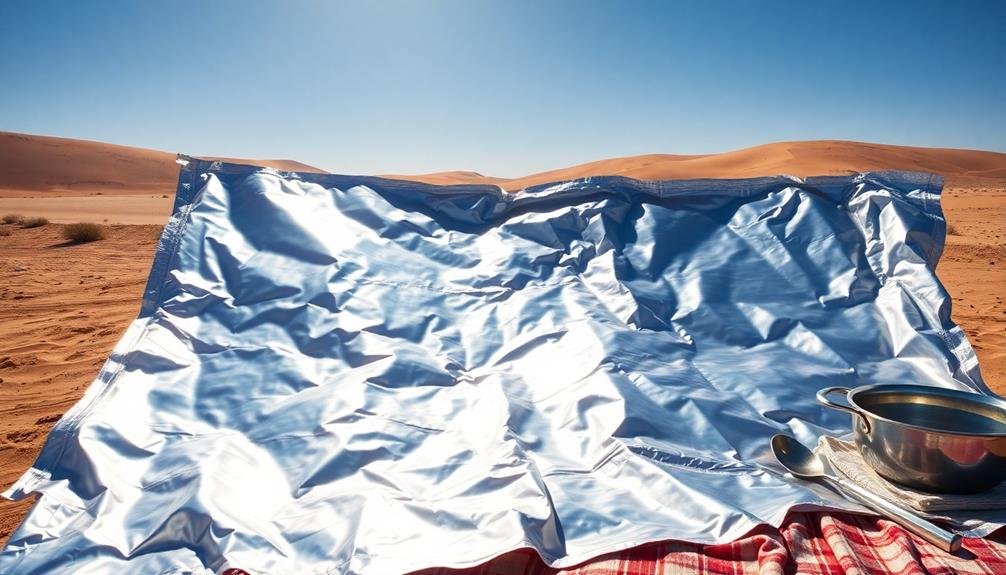
Almost any reflective material can be used to create a homemade sun cooker. The most effective options include aluminum foil, mylar, and reflective metal sheets.
Aluminum foil is readily available and inexpensive, making it a popular choice for DIY sun cookers. It's easy to work with and can be shaped to fit various designs. However, it's less durable than other options and may need frequent replacement.
Mylar, a type of polyester film with a metallic coating, is another excellent choice. It's more durable than aluminum foil and provides better reflectivity. You can find mylar in emergency blankets or purchase it in sheets. It's lightweight and flexible, allowing for easy manipulation in your sun cooker design.
For a more permanent solution, consider using reflective metal sheets like polished aluminum or stainless steel. These materials offer superior durability and longevity but may be more expensive and challenging to work with.
When selecting your reflective material, consider factors such as cost, availability, durability, and ease of use. Remember that the more reflective your material, the more efficiently your sun cooker will concentrate sunlight and generate heat for cooking.
Insulation
Insulation plays an essential role in the efficiency of your homemade sun cooker.
You'll want to focus on materials that can effectively trap heat and minimize heat loss to the environment.
Consider using common household items like newspaper, cardboard, or bubble wrap, or invest in specialized insulating materials such as foam board or fiberglass for peak performance.
Importance of Proper Insulation
Proper insulation plays an essential role in the efficiency of your homemade sun cooker. It's vital for maintaining the high temperatures needed for cooking and preventing heat loss. Without adequate insulation, your sun cooker won't reach ideal temperatures, resulting in longer cooking times and potentially undercooked food.
You'll want to choose insulation materials that can withstand high temperatures without degrading or releasing harmful fumes. Common options include fiberglass, wool, or reflective bubble insulation. These materials trap air, creating a barrier that slows heat transfer.
When selecting insulation, consider its R-value, which measures thermal resistance. The higher the R-value, the better the insulation's performance.
Properly insulating your sun cooker involves covering all surfaces except the reflective area. Pay special attention to edges and corners, as these are common areas for heat loss.
You'll also need to insulate the cooking chamber, ensuring it's sealed tightly to prevent hot air from escaping. Remember, the thickness of your insulation matters; generally, a layer of 1-2 inches is sufficient for most sun cookers.
Best Insulating Materials
Frequently, the most effective insulating materials for homemade sun cookers are those that combine high R-values with heat resistance and affordability.
You'll want to focus on options that trap air effectively while withstanding the high temperatures generated in your cooker.
Fiberglass insulation is a popular choice due to its excellent insulating properties and low cost. It's widely available and easy to work with, but make sure you handle it carefully to avoid skin irritation.
Alternatively, consider rigid foam boards like polyisocyanurate or extruded polystyrene. These offer high R-values per inch and are moisture-resistant, making them ideal for outdoor use.
For a more eco-friendly option, you might opt for natural materials like wool or cotton. While they may not be as efficient as synthetic options, they're biodegradable and sustainable.
Reflective materials such as aluminum foil or mylar can also boost insulation when used in conjunction with other materials.
Don't overlook the potential of recycled materials. Shredded newspaper or cardboard can be effective when packed tightly.
Whatever you choose, make sure it's sealed properly to prevent moisture infiltration and maintain its insulating properties over time.
Cooking Container
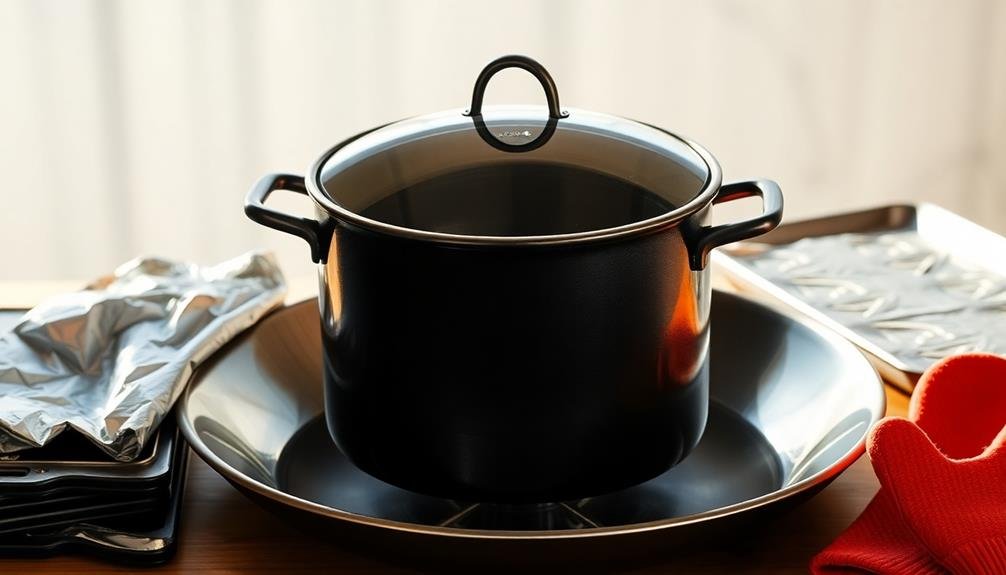
When building your sun cooker, selecting the right cooking container is essential for efficient heat absorption and food safety.
You'll want to choose a dark-colored, thin-walled pot or pan that can withstand high temperatures without releasing harmful chemicals.
Safe material options include cast iron, stainless steel, and enamel-coated cookware, all of which are excellent choices for your solar cooking needs.
Choosing the Right Container
At the heart of your homemade sun cooker lies the cooking container, an essential component that can make or break your solar cooking experience. When selecting the right container, opt for dark-colored pots or pans that absorb heat efficiently. Thin-walled, lightweight materials like aluminum or thin-gauge steel work best, as they heat up quickly and evenly.
Consider using lidded pots to trap steam and maintain consistent temperatures. Glass or ceramic dishes can also be effective, but they may take longer to heat up. Avoid using plastic containers, as they can melt or release harmful chemicals when exposed to high temperatures.
Size matters too. Choose a container that fits comfortably within your sun cooker's reflective area without touching the sides. This guarantees maximum heat absorption and even cooking. For most home sun cookers, a 2-3 quart pot is ideal.
Don't forget about handles. Look for containers with heat-resistant handles or use pot holders to safely remove your food when it's done.
Safe Material Options
With the right container in mind, let's explore safe material options for your sun cooker. You'll want to choose materials that can withstand high temperatures and won't leach harmful chemicals into your food. Glass, ceramic, and certain metals are excellent choices for your cooking container.
Glass containers, like Pyrex or borosilicate dishes, are ideal for sun cooking. They're non-reactive, heat-resistant, and allow you to see your food as it cooks. Ceramic pots and dishes are also great options, as they retain heat well and are safe for food preparation.
When it comes to metals, stick with food-grade stainless steel or cast iron. These materials are durable, conduct heat efficiently, and won't react with your food. Avoid using aluminum, as it can leach into acidic foods and potentially affect taste.
Here's a quick reference table for safe material options:
| Material | Pros | Cons |
|---|---|---|
| Glass | Non-reactive, transparent | Can break if dropped |
| Ceramic | Retains heat well | Heavy, can chip |
| Stainless Steel | Durable, lightweight | Not transparent |
Remember to choose dark-colored containers when possible, as they absorb heat more effectively, enhancing your sun cooker's performance.
Thermometer
A thermometer is an essential component of your homemade sun cooker. It allows you to monitor the internal temperature of your cooker, guaranteeing food safety and ideal cooking conditions. When choosing a thermometer, opt for one that can withstand high temperatures, typically up to 500°F (260°C) or more.
Look for a digital thermometer with a long probe, which will enable you to check food temperatures without opening the cooker and losing heat. Some thermometers come with a clip-on feature, allowing you to attach them to the side of your cooking pot for continuous monitoring. If possible, select a model with an alarm function that alerts you when your desired temperature is reached.
Consider investing in an infrared thermometer as well. This non-contact device can measure surface temperatures quickly and accurately, helping you assess the efficiency of your reflective surfaces and identify any hot spots.
Remember to calibrate your thermometer regularly to guarantee accuracy. You can do this by testing it in boiling water (212°F or 100°C at sea level) and making adjustments if necessary. With a reliable thermometer, you'll have better control over your sun cooking process and achieve consistent results.
Clear Oven Bag
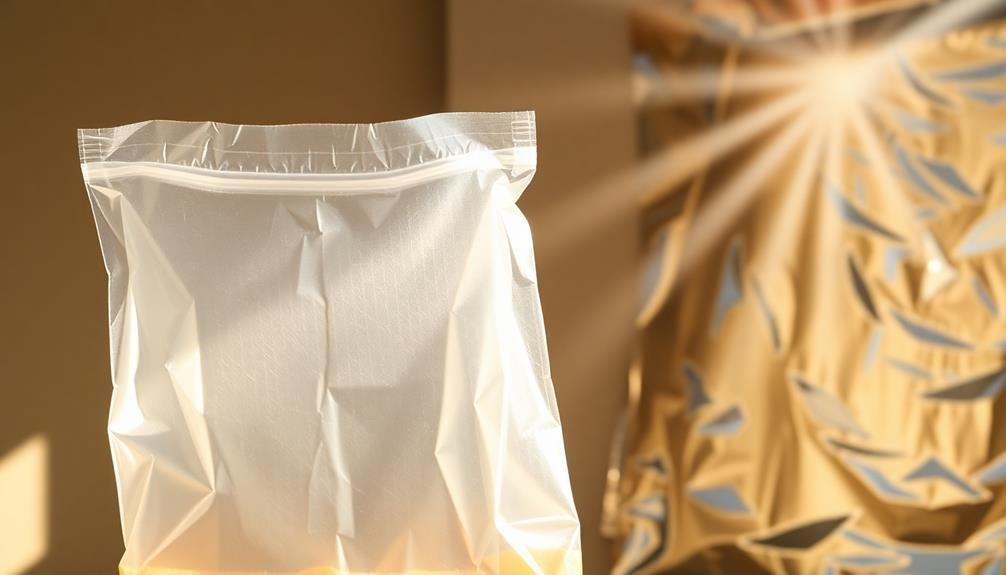
Moving from temperature monitoring to heat retention, clear oven bags play a key role in your homemade sun cooker. These bags, typically made of heat-resistant nylon or polyester, create a greenhouse effect by trapping solar heat and moisture around your food. They're essential for efficiently cooking meals using only the sun's energy.
When selecting a clear oven bag for your sun cooker, consider the following factors:
| Feature | Importance | Tips |
|---|---|---|
| Size | Fits cooking vessel | Choose slightly larger size |
| Thickness | Durability and heat retention | Opt for thicker bags |
| Heat resistance | Withstands high temperatures | Look for 400°F+ rating |
You'll want to use a new bag for each cooking session to guarantee ideal performance and food safety. To use the bag, simply place your cooking pot or dish inside, seal it tightly, and position it in your sun cooker. The clear material allows sunlight to penetrate while preventing heat from escaping, creating an optimal environment for slow-cooking your meals.
Remember to handle the bag carefully when removing it from the cooker, as it will be hot and may contain steam. With proper use, clear oven bags will greatly enhance your sun cooking experience.
Dark-Colored Cookware
Dark-colored cookware is essential for maximizing heat absorption in your homemade sun cooker. When choosing pots and pans for solar cooking, opt for those with matte black or dark blue exteriors. These colors absorb and retain heat more efficiently than lighter shades, allowing your food to cook faster and more evenly.
Cast iron, enamel-coated cast iron, and dark anodized aluminum are excellent choices for solar cooking. They're durable, conduct heat well, and maintain temperature consistently. Avoid shiny or reflective surfaces, as they'll deflect sunlight rather than absorb it.
If you don't have dark cookware, you can temporarily darken light-colored pots by covering them with non-toxic black paint or wrapping them in dark fabric. Make certain your cookware has tight-fitting lids to trap heat and moisture inside.
For best results, use thin-walled, shallow pots with wide bottoms. These allow for maximum surface area exposure to sunlight and promote even cooking.
Remember to use pot holders when handling your cookware, as it can become extremely hot in the sun cooker.
Sturdy Base

While your cookware absorbs sunlight, it needs a solid foundation to rest on. A sturdy base is essential for your homemade sun cooker's stability and efficiency. You'll want to choose a material that's durable, weather-resistant, and can withstand high temperatures.
Plywood is an excellent option for your base. It's affordable, easy to work with, and provides a flat surface. Be certain to select exterior-grade plywood that's at least 3/4 inch thick to prevent warping.
Alternatively, you can use a metal sheet, such as aluminum or stainless steel. These materials offer superior heat resistance and longevity but may be more expensive.
When constructing your base, verify it's large enough to accommodate your cookware and any reflective surfaces you'll be using. Add reinforcements underneath to prevent sagging, especially if you're using plywood.
You can also attach adjustable legs or a swivel mechanism to help angle your cooker towards the sun for maximum efficiency.
Don't forget to paint your base with a dark, heat-absorbing color to maximize solar energy capture. This will complement your dark cookware and enhance your sun cooker's overall performance.
Frequently Asked Questions
How Long Does It Take to Cook Food in a Homemade Sun Cooker?
You'll find cooking times in a homemade sun cooker vary widely. It depends on factors like sunlight intensity, cooker design, and food type. Generally, you're looking at 1-5 hours for most dishes. Be patient and monitor closely.
Can a Sun Cooker Be Used on Cloudy Days?
You can use a sun cooker on cloudy days, but it won't be as effective. You'll experience longer cooking times and lower temperatures. For best results, you should wait for sunny days to use your solar cooker.
What Types of Food Are Best Suited for Cooking in a Sun Cooker?
You'll find sun cookers work best with foods that don't need high temperatures. Try slow-cooking dishes like stews, soups, and rice. Vegetables, fruits, and meats also do well. Avoid recipes requiring precise temperatures or quick cooking times.
Is It Safe to Leave a Sun Cooker Unattended While Cooking?
It's not recommended to leave your sun cooker unattended. You'll want to monitor it regularly for safety reasons. While it's unlikely to cause fires, you should check on your food's progress and guarantee the cooker remains stable.
How Do You Adjust Cooking Times for Different Seasons or Latitudes?
You'll need to adjust cooking times based on available sunlight. In summer or near the equator, you'll have more intense sun. During winter or at higher latitudes, extend cooking times to compensate for weaker solar energy.
In Summary
You're now equipped with the knowledge of essential materials for your homemade sun cooker. By combining reflective materials, insulation, proper containers, and monitoring tools, you'll harness the sun's power to create eco-friendly meals. Don't forget the clear oven bag to trap heat and dark-colored cookware to absorb it efficiently. With a sturdy base, you've got a reliable outdoor cooking solution. Get creative, experiment with recipes, and enjoy the sustainable cooking adventure you've initiated!
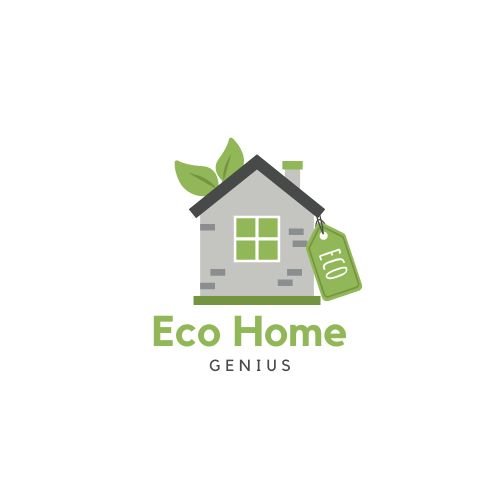
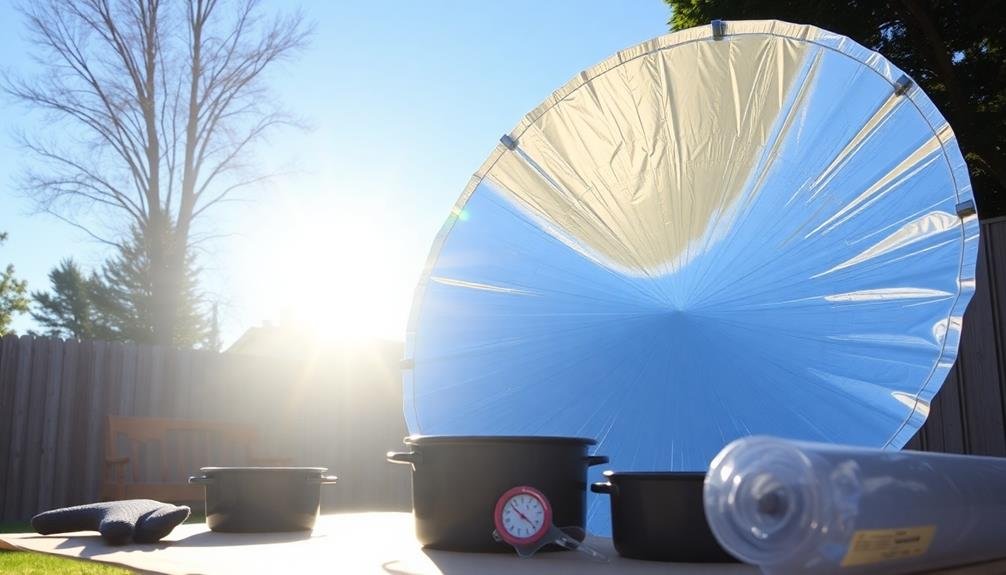
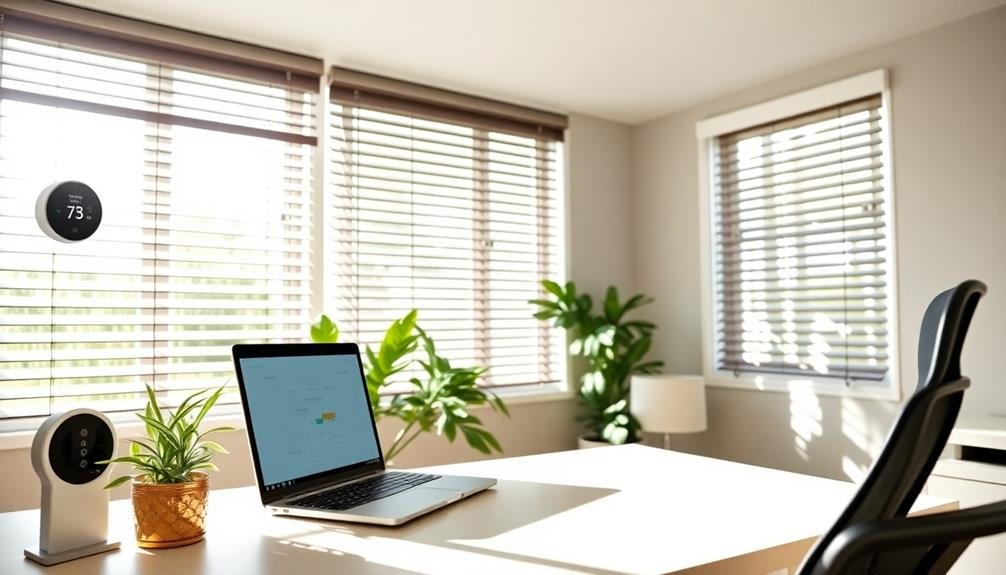
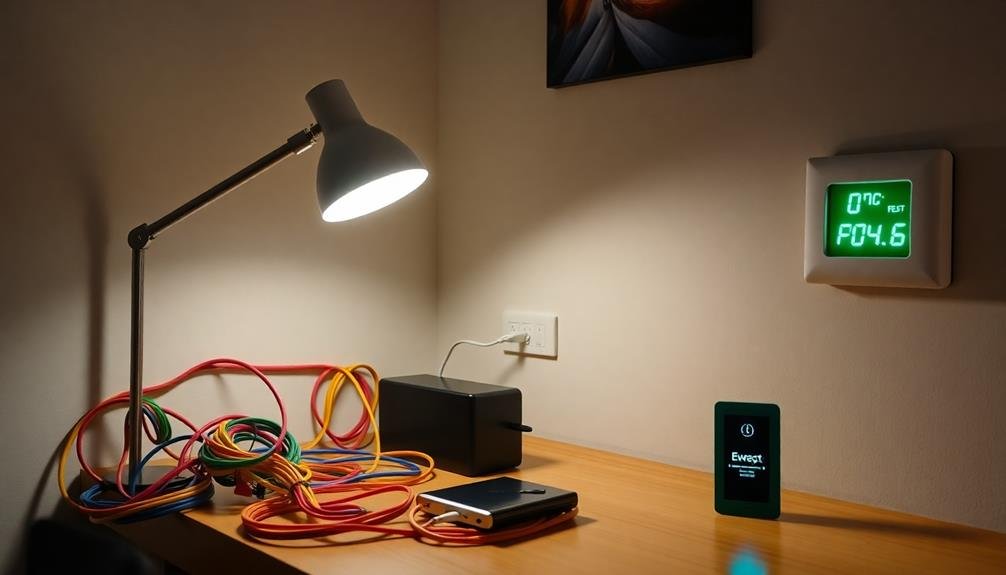

Leave a Reply